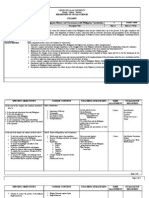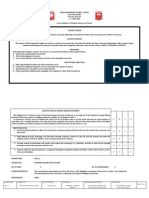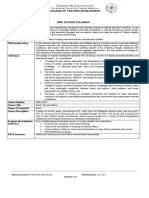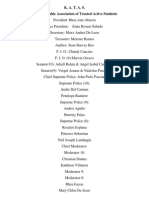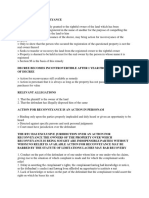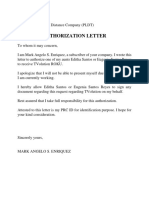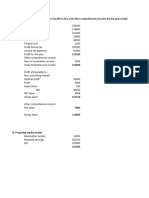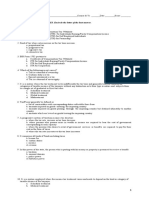SOC. SCI. 2 Syllabus
SOC. SCI. 2 Syllabus
Uploaded by
Mark Angelo S. EnriquezCopyright:
Available Formats
SOC. SCI. 2 Syllabus
SOC. SCI. 2 Syllabus
Uploaded by
Mark Angelo S. EnriquezCopyright
Available Formats
Share this document
Did you find this document useful?
Is this content inappropriate?
Copyright:
Available Formats
SOC. SCI. 2 Syllabus
SOC. SCI. 2 Syllabus
Uploaded by
Mark Angelo S. EnriquezCopyright:
Available Formats
CENTRO ESCOLAR UNIVERSITY Manila * Makati * Malolos DEPARTMENT OF SOCIAL SCIENCES SYLLABUS
COSSCI 12
Subject Code
Soc Sci 12
Subject Title
Principles of Economics, Taxation and Land Reform with Cooperatives
Descriptive Title
3
Unit (s)
3
Hour (s) / Week
Course Description :
A three unit course that deals with the study of the Principles of Economics, Taxation, Land and Agrarian Reform and Cooperatives. It focuses on the application of the concepts of Economic principles to maximize utilization of limited resources for the production of goods and services in order to satisfy mans unlimited wants. The course also relates the fundamental principles of Economics, Taxation, Agrarian Reforms and Cooperatives and its application to the improvement of mans quality of life. Prerequisites General Objectives : None : Upon the completion of the course the students are expected to:
1. Demonstrate knowledge, skills and positive attitudes to the concepts and principles of Economics as applied to real life situations; 2. Identify and differentiate the components or divisions of Economics. 3. Manifest understanding of the fundamental principles of Economics and relate them to current economic problems and issues in the country. 4. Discuss the different support programs of the government in relation to redistribution of lands 5. Identify their roles and responsibilities in the achievement of the economic goals of the government, i.e. poverty alleviation, sustainable development and attainment of higher standard of living among its citizens. 6. Analyze the importance of taxation, its aspects, and classification. 7. Demonstrate the correct computation of income taxation 8. Apply the principles of cooperativism 9. Practice honesty and truthfulness in computing income taxation.
Page 1 of 9
SPECIFIC OBJECTIVES
COURSE CONTENT
TEACHING STRATEGIES
TIME ALLOTMENT 3 hours
EVALUATIVE MEASURES Case Analysis, Recitation Quizzes Reaction Paper Group Activity Grade
At the end of the chapter, the students are expected I. Introduction to Basic to: Economics - Lecture A. The Concept of Economics - Power Point 1. Discuss the relationship between economics 1. Definition of Economics Presentation and health 2. Fundamental / Basic Economic - Class Discussion Problem 2. Explain the importance of the discipline of Elements of Economics Economics and health to national development B. The Concept of Health - Lecture 3. Enumerate the different economic and health 1. Definition of Health - Group Discussion problems in the country 2. Determinants of Health - Film Viewing 3. Health System Models 4. Present probable solutions to address current 4. Health Resources economic problems. 5. Government Health Objectives 5. Find out how factors of health affect individuals in society. C. Essentials of Health and Discussion Economics Select group of structures 1. Epidemiology 2. Expenditures in Health Care Teach from among the Delivery System student 3. Access to Health Care Educate teachers and facilitators Manage teachers and students Group report
5 hours
Case study Graded recitation
Page 2 of 9
SPECIFIC OBJECTIVES 1. 2. Define Economics as a subject in social science Discuss the principles of Economics and show its conformity to real life cases and situations Determine the scientific process of resolving the economic issues and problems
COURSE CONTENT II. Introduction to: Principles and Concepts of Economics A. Relationship of Economics with other Social Science subjects B. Divisions of Economics 1. Microeconomics 2. Macroeconomics
TEACHING STRATEGIES Board work completing a puzzle of concepts and ideas about economics
TIME ALLOTMENT
EVALUATIVE MEASURES
2 hours
Graded Recitation Presentation of Reaction paper
3.
4. Use the scientific approaches in solving economic problems and other issues
- Operationalizing a group of students definition & emphasize human peaceful coC. Fundamental Institutions of the existence in society Present Economic System - A case study on an economic phenomena D. Using the scientific approaches in and how scientific solving economic problems. approach is employed 1. 2. 3. 4. 5. 6. 7. observation formulation of hypothesis testing the hypotheses making value judgments forming generalization conclusion application Film showing Documentary Films - eye witness - Phil 2000 - Pobreng Pinoy - Juan Tanga
2 hours
2 hours
Page 3 of 9
SPECIFIC OBJECTIVES At the end of the chapter, the students will be able to: 1. Broaden the students viewpoint on issues that actually exist in the economy. 2. Identify the available economic resources for the satisfaction of human wants and needs. 3. Motivate students to identify specific needs; to identify the available resources in the surroundings to satisfy their needs 4. Be able to match these resources with needs in the solution of specific economic problems. 5. To ask relevant economic questions / problems. 6. Recognize the need for analytical thinking in the discussion of the different economic problems.
COURSE CONTENT III. The Economic world A. Different Economic Systems B. Mans Economic Needs, Resources and Problems 1. Land a. Kinds & uses b. Labor c. Capital d. Entrepreneurial Ability e. Foreign Exchange C. *Four Fundamental Economic Questions / Problems 1. what to produce? 2. how to produce? 3. how much to produce? 4. for whom to produce?
TEACHING STRATEGIES Presenting a diagram of the various sectors and the flow of resources in the economy. Film showing on Recycling, Efficiency and Maximization of Vital Resources Reportorial activity on the use of Entrepreneurship in Third World Economics Graded recitation Case Study in Production Process to apply the specific objectives
TIME ALLOTMENT 3 hours
EVALUATIVE MEASURES Quizzes Graded Recitation
2 hours
2 hours Role playing manifesting the evaluation of human activities emphasizing womens role.
Page 4 of 9
SPECIFIC OBJECTIVES 1. Define demand and supply 2. Enumerate the determinants of demand and supply 3. Explain how demand and supply affect consumers and producers. 4. Discuss the role and importance of the price system. 5. Identify different types of market structure.
COURSE CONTENT IV. Basic Principles in Microeconomics A. Prices of Goods and Services 1.Law of Demand 2.Law of Supply 3.Law of Supply and Demand 4. Profit Maximization 5. Analysis and Criticisms of the Price System B. Production 1. Factors of Production 2. Law of Diminishing Returns 3. Cost of Production 4. Cost Minimization C. Market Structures 1.Perfect Competition 2.Monopolistic Competition 3.Oligopoly 4.Monopoly D. Factor Markets and Income Distribution 1. Factor Payments a. Wage b. Rent c. Interest d. Profit 2. Income Distribution E. Business Organizations 1. Single Proprietorship 2. Partnership 3. Corporations
TEACHING STRATEGIES Seatwork on plotting demand and supply schedules Exercises on determining the market price Conduct survey form on the prices of goods & services demanded on weekly and monthly basis Slides presentation on different types of Markets Ocular visit to a market Narration of marketing experiences in any market types or structures.
TIME ALLOTMENT
EVALUATIVE MEASURES Quizzes
3 hours Graded Recitation Submission of worksheets found at the end of the chapter of the manual 3 hours
2 hours
Submission of a written report of their ocular visit in the market
2 hours
2 hours
Page 5 of 9
SPECIFIC OBJECTIVES At the end of the chapter, the students will be able to: 1. Understand the a relationship between the two approaches in computing the value of GNP
COURSE CONTENT V. Basic Principles in Macroeconomics A. National Income Accounts 1. Measures of Income and Output a. Gross National Product a. income approach b. expenditure approach c. service group approach b. Net National Product c. National Income d. Personal Income e. Disposable Personal Income f. Gross Domestic Product 2. Nominal and Real GNP 2.1 Price Indexes a. Wholesale Price Index b. Consumer Price Index c. GNP Implicit Price Index 2. 2 Base Period
TEACHING STRATEGIES Comparative analysis of any past significant year in Philippines GNP statistics and the current one. Evaluative study of the results in the comparative analysis done. An educational tour or visit to money museum and Central Bank of the Philippines.
TIME ALLOTMENT 3 hours
EVALUATIVE MEASURES Graded recitation Group research Quizzes
2. Discuss the value of money and its influence to the various sectors of the economy.
2 hours
1. Explain the importance of an efficient tax collection system to the delivery of health care service, economic welfare
VI. Basic Taxation A. Definition of Taxation B. Importance & Function of Taxation C. Principles of Income Taxation D. Classification of Taxes E. Forms of Escape from Taxation F. Computation of Taxes G. Other Government Taxes
Lecture Class Discussion
3 hours
Seatwork Quiz Recitation
Page 6 of 9
SPECIFIC OBJECTIVES
COURSE CONTENT
TEACHING STRATEGIES
TIME ALLOTMEN T
EVALUATIVE MEASURES
1. Describe how nations income distributed 2. Identify the determinants of income differences 3. Distinguish approaches in measuring and addressing poverty 4. Recognize reasons for rising cost of health care
VII. Income, Poverty and Health Care A. Income B. Poverty C. Health Care
Differentiation of developed agrarian reforms in other countries Internet activity assignment and graded recitation Film showing on the prevalent problems regarding lands
2 hours
Research paper Essay quiz
1. Understand the Phil Agrarian structure 2. Explain how agrarian reform may be viewed as a development tool of growth and equity 3. Evaluate the features of CARP as a program to alleviate poverty among rural poor households
VIII. Land Reform A. Nature of Phil. Agrarian Reform B. Historical Background C. Agrarian Problems D. P.D. II 27 E. CARP features
2 hours
Research paper Essay quiz
1. Discuss the principles of cooperative and relate how it can help develop health programs in the Philippines 2. Explain how a cooperative is organized As one of the business organization 3. Describe the different types of cooperatives
IX. A. Cooperatives 1. Meaning of Cooperative 2. Objectives of Cooperative 3. Principles of Cooperative 4. Organization of Cooperative 5. Purposes of the Cooperative 6. Types of Cooperative 7. Steps in Organizing a Cooperative 8. Why cooperatives fail
Film Showing Discussion Reporting on the current cooperatives issues Interview of Key Officers of CEU Consumers & Credit Cooperatives
2 hours
Quiz Recitation
1 hour
Oral Report on the Result of the Interview
Page 7 of 9
SPECIFIC OBJECTIVES
COURSE CONTENT
TEACHING STRATEGIES
TIME ALLOTMEN T
EVALUATIVE MEASURES
At the end of the chapter, the students will able to: 1. Distinguish between General and Institutional Economics 2. Understand global issues affecting the peoples livelihood and health care in national 3. Describe how a better quality of life may be attained.
X. Current and Global Economic Issues Debate on the pros and A. WTO, APEC and 21st Century cons of globalization Global Program (Agenda 21) 1. Trends in Trade Liberalization a. tariffs and quotas b. anti-dumping laws c. intellectual property rights B. Sustainable Development areas/concerns 1. Values Integration a. economic b. social c. ecological d. cultural e. science and technology f. education 2. Role of Women 3. Gender Sensitivity 4. Population Debate on the pros and cons of Mindanao peace process Invite resource speakers on special topics (cultural minority, women in development, ecological development.) Project collage, diorama on a chosen area or aspect
3 hours
Essay quiz Graded recitation Research work
2 hours
Page 8 of 9 Gabay, Bon Kristofer, et al. Health Economics, Manila: Rex Store, 2009. Brue, Stanley and Campbell, Mcconell. Economics,Problems, and Policies Boston: Mcgrawhill, 2005 Lipsey, Richard,et al. Economics. New York: Harpen and Row, 1996
Slavin, Stere. Economics. New York. John Wiley and sons, Inc, 1996 Fajardo, Feliciano, Economics, Manila Rex Store, 1995 Taylor, John. Principles of Microeconomics. Boston, Massachusetts: Houghton Mifflin Co., 1995 Amacher, Ryan C. Principles of Economies: Ohio South Western Co., 1993 Villegas, Bernardo, An Introduction to Economics, Manila: Sinagtala, Publications, 1993 Boyes, William and Michael Melvin. Economics. Boston: Houghton Miffin Co, 1991. Dornbusch, Rudiger and Stanley Fisher. Macroeconomics, 5th Edition: New York Mcgrawhill, 1990. Amacher, Ryan C. Principles of Economies: Ohio South Western Co., 1993 Sicat, Gerardo, Economics, Manila; National Bookstore, 1983 Electronic References: http://www.ilo.org/global http://www.blackwellpublishing.com/journal http://www.supremecourt.gov.ph/ http://www.doh.gov.ph/ http://www.dar.gov.ph/ http://www.dole.gov.ph/ http://www.bir.gov.ph/ A Student's Guide to Economics, Source: http://www.scribd.com/doc/18112/A-Students-Guide-to-Economics Globalization101 : A Student's Guide to Globalization, Source: http://www.globalization101.org/ Gapminder for a fact-based world view, Source: http://www.gapminder.org/ Think Economics: Modeling Economic Principles, Source: http://www.whitenova.com/thinkEconomics/ Prepared by: Ramon Andal, Jr., M.A Mark Angelo S. Enriquez, M.A. (Cand.) Ibn Khaldon S. Kuhutan, M.A. (Cand.) Crisenta T. Fontanilla, M.A Juliana M. Laraya, Ph.D Ruth Santos, M.A Lorena C. Valerio, MAGA Imelda C. Nery, Ph.D. Head, Social Sciences Department S.Y. 2011-2012 Revised 04/13/11 Page 9 of 9
You might also like
- Questions For DiscussionDocument2 pagesQuestions For DiscussionCojocaru Mihai0% (2)
- Social System SyllabusDocument4 pagesSocial System SyllabusAnonymous VcZWdwp0Z4No ratings yet
- Rural Sociology SyllabusDocument9 pagesRural Sociology SyllabusFarrah Jane Infante100% (1)
- CFLM 1 Check Progress No. 9: InstructionsDocument2 pagesCFLM 1 Check Progress No. 9: InstructionsCriseljosa LacapagNo ratings yet
- Soc. Sci. 1 SyllabusDocument9 pagesSoc. Sci. 1 SyllabusMark Angelo S. Enriquez89% (9)
- Module 3 Ge 4 (Readings in Philippine History) : Maria Ivy A. Giray-Gacosta, RcrimDocument28 pagesModule 3 Ge 4 (Readings in Philippine History) : Maria Ivy A. Giray-Gacosta, RcrimArt russel galitNo ratings yet
- NSTP11 National Service Training Program 1: Prerequisite: None Credits: Three (3) Units Number of Hours: 54 HoursDocument2 pagesNSTP11 National Service Training Program 1: Prerequisite: None Credits: Three (3) Units Number of Hours: 54 HoursAeron ArestaNo ratings yet
- Syllabus PhiloDocument5 pagesSyllabus PhiloMark Anthony Fabrigas Catubay67% (3)
- An Introduction To Social ScienceDocument3 pagesAn Introduction To Social ScienceChrisma EderNo ratings yet
- Social Studies Reviewer 7Document6 pagesSocial Studies Reviewer 7AlexaNo ratings yet
- TEST ITEMS IN PHILIPPINE HISTORY-with ANSWERSDocument5 pagesTEST ITEMS IN PHILIPPINE HISTORY-with ANSWERSKathleen Irish Gunday100% (1)
- EconomicsDocument2 pagesEconomicsangie vibarNo ratings yet
- Art Appreciation SyllabusDocument9 pagesArt Appreciation SyllabusJellane SeletariaNo ratings yet
- Readings in Philippine History LESSON 12Document34 pagesReadings in Philippine History LESSON 12Raldge L RoniganNo ratings yet
- Reviewer in Gender and SocietyDocument19 pagesReviewer in Gender and SocietyNieL ReSpiCiONo ratings yet
- The Contemporary World COURSE OUTLINEDocument2 pagesThe Contemporary World COURSE OUTLINEChristine TejonesNo ratings yet
- Rizal Life and Works ModuleDocument102 pagesRizal Life and Works ModuleEricha Mae LenderoNo ratings yet
- Syllabus - Edu118Document7 pagesSyllabus - Edu118genesisgamaliel montecinoNo ratings yet
- Trends and Issues in Social Studies ReviewDocument43 pagesTrends and Issues in Social Studies ReviewL.G ConsNo ratings yet
- College of Teacher Education: Republic of The Philippines Cagayan State University Andrews Campus, Tuguegarao CityDocument6 pagesCollege of Teacher Education: Republic of The Philippines Cagayan State University Andrews Campus, Tuguegarao CityVignette San AgustinNo ratings yet
- Political Economy SyllabusDocument7 pagesPolitical Economy SyllabusApril Gay PugongNo ratings yet
- Module 5Document23 pagesModule 5Zakurieh NeriNo ratings yet
- Phil History 2013Document12 pagesPhil History 2013Hannibal F. Carado100% (3)
- Our CountryDocument22 pagesOur CountryJake Marcelo-TapatNo ratings yet
- National Differences in Political, Economic, and Legal SystemsDocument36 pagesNational Differences in Political, Economic, and Legal Systemslauraevalinaa100% (1)
- SYLLABUS 231790658-Philippine-History-and-Government PDFDocument6 pagesSYLLABUS 231790658-Philippine-History-and-Government PDFJanie Mary BonzNo ratings yet
- Basic Economics, Taxation and Agrarian ReformDocument66 pagesBasic Economics, Taxation and Agrarian ReformNiccolo G. Chiongbian100% (1)
- GEC2 - Course OutlineDocument3 pagesGEC2 - Course OutlineMarlyn LitaNo ratings yet
- Lesson 1Document32 pagesLesson 1Miyu KissNo ratings yet
- Module 2 PPT Ge Readings in Philippine History 1Document31 pagesModule 2 PPT Ge Readings in Philippine History 1Flores, Mary Natielyn Grace100% (1)
- Soc. Sci. 3 SyllabusDocument5 pagesSoc. Sci. 3 SyllabusMark Angelo S. Enriquez100% (2)
- Social Networking For Social Integration-Week 3Document50 pagesSocial Networking For Social Integration-Week 3Dexter Huliganga100% (1)
- The Contemporary World - PDF - GUIDEDocument23 pagesThe Contemporary World - PDF - GUIDEHIEZEL BAYUGNo ratings yet
- Chapter 1 - Introduction To Economic TheoryDocument12 pagesChapter 1 - Introduction To Economic TheoryMaria Teresa Frando CahandingNo ratings yet
- 1-Introduction To EthicsDocument21 pages1-Introduction To EthicsPercival ArcherNo ratings yet
- Basic Microeconomics: Chapter 3: Elasticity of Demand and SupplyDocument12 pagesBasic Microeconomics: Chapter 3: Elasticity of Demand and SupplyJane Gonzaga100% (1)
- Readings in Philippine HistoryDocument12 pagesReadings in Philippine HistoryJoel PichonNo ratings yet
- Brief HistoryDocument24 pagesBrief HistoryBhino S. AlvinNo ratings yet
- Humanities SyllabusDocument3 pagesHumanities SyllabusPablo Jan Marc FilioNo ratings yet
- Creed Review CenterDocument9 pagesCreed Review CenterKimberly MirantesNo ratings yet
- Understanding The Self 12Document6 pagesUnderstanding The Self 12Tulabing ChaterineNo ratings yet
- Social Studies Major - Set B - Part 1Document3 pagesSocial Studies Major - Set B - Part 1Jane Uranza CadagueNo ratings yet
- SS1D ReviewerDocument34 pagesSS1D ReviewerYou NichNo ratings yet
- Syllabus-Rizal's Life & WorksDocument17 pagesSyllabus-Rizal's Life & WorksSol JaraveloNo ratings yet
- Final Exam Part I Asian StudiesDocument2 pagesFinal Exam Part I Asian StudiesAlma Mae CalivoNo ratings yet
- Lesson 1&2 - Economics PDFDocument7 pagesLesson 1&2 - Economics PDFTrixie CabotageNo ratings yet
- Art Appreciation Quiz 2Document1 pageArt Appreciation Quiz 2jisoo rabbitNo ratings yet
- Earning Outcomes: LSPU Self-Paced Learning Module (SLM)Document27 pagesEarning Outcomes: LSPU Self-Paced Learning Module (SLM)Joanne Cristie Tolopia100% (1)
- Science, Technology and SocietyDocument11 pagesScience, Technology and SocietyJames Andrew DalitNo ratings yet
- Writing The Research ProposalDocument3 pagesWriting The Research Proposalfay47No ratings yet
- Importance of Science and Technology Studies in ContemporaryDocument49 pagesImportance of Science and Technology Studies in ContemporaryJeemCarloFagelaPula0% (1)
- Life and Works of Rizal Course Outline: National UniversityDocument2 pagesLife and Works of Rizal Course Outline: National UniversityAngelica Angeles25% (4)
- The Teaching ProfessionDocument4 pagesThe Teaching ProfessionOrmon Angel AndesNo ratings yet
- Csso103 1Document6 pagesCsso103 1PanasheNo ratings yet
- Contemporary World ReviewerDocument8 pagesContemporary World ReviewerSunshine KhuletzNo ratings yet
- Intro To Pop Culture 2020Document50 pagesIntro To Pop Culture 2020Ledine Arcenal OdtohanNo ratings yet
- General Education Subject DescriptionDocument18 pagesGeneral Education Subject DescriptionCharo GironellaNo ratings yet
- SSE10 - Socio-Cultural AnthropologyDocument12 pagesSSE10 - Socio-Cultural Anthropologydave puertollano100% (1)
- Media and Information LiteracyDocument65 pagesMedia and Information LiteracyKali LinuxNo ratings yet
- Basic Economics S2d Sem SY 2014 2015Document6 pagesBasic Economics S2d Sem SY 2014 2015Wynn Francis Jr NuñalNo ratings yet
- Kumustahan - PLV STs - APDocument9 pagesKumustahan - PLV STs - APMark Angelo S. EnriquezNo ratings yet
- Law On ContractsDocument54 pagesLaw On ContractsMark Angelo S. Enriquez100% (1)
- EmploymentDocument10 pagesEmploymentMark Angelo S. EnriquezNo ratings yet
- Lesson Plan TemplateDocument3 pagesLesson Plan TemplateMark Angelo S. EnriquezNo ratings yet
- Jeopardy TemplateDocument27 pagesJeopardy TemplateMark Angelo S. EnriquezNo ratings yet
- K. A. T. A. S. Knowledgeable Association of Trusted Active StudentsDocument1 pageK. A. T. A. S. Knowledgeable Association of Trusted Active StudentsMark Angelo S. EnriquezNo ratings yet
- Total 12, 400Document1 pageTotal 12, 400Mark Angelo S. EnriquezNo ratings yet
- Research Project: Human Evolution: Australopithecus Homo Erectus Homo SapienDocument22 pagesResearch Project: Human Evolution: Australopithecus Homo Erectus Homo SapienMark Angelo S. EnriquezNo ratings yet
- Answer Key - Humms MidtermDocument2 pagesAnswer Key - Humms MidtermMark Angelo S. EnriquezNo ratings yet
- Certification - Dress CodeDocument1 pageCertification - Dress CodeMark Angelo S. EnriquezNo ratings yet
- Custom Search: Today Is Wednesday, September 27, 2017Document4 pagesCustom Search: Today Is Wednesday, September 27, 2017Mark Angelo S. EnriquezNo ratings yet
- Pale Oli TicDocument7 pagesPale Oli TicMark Angelo S. EnriquezNo ratings yet
- Action For ReconveyanceDocument19 pagesAction For ReconveyanceMark Angelo S. Enriquez100% (1)
- Modyul 3, Aralin 2, Balik-AralDocument11 pagesModyul 3, Aralin 2, Balik-AralMark Angelo S. EnriquezNo ratings yet
- PLDT Authorization Letter SampleDocument1 pagePLDT Authorization Letter SampleMark Angelo S. EnriquezNo ratings yet
- Groupings For 3Rd To 4Th Grading Performance Tasks: Group 1: - 1 2 3 4 5 6 7 8 9 10Document5 pagesGroupings For 3Rd To 4Th Grading Performance Tasks: Group 1: - 1 2 3 4 5 6 7 8 9 10Mark Angelo S. EnriquezNo ratings yet
- BASIC ACCOUNTING WORKBOOK Final Version 1Document50 pagesBASIC ACCOUNTING WORKBOOK Final Version 1ynarchive00No ratings yet
- Consumer Insights Brochure-2016Document44 pagesConsumer Insights Brochure-2016JunnLRNo ratings yet
- Investment (Financial Asset at Fair Value)Document3 pagesInvestment (Financial Asset at Fair Value)Justine Carl Nikko NakpilNo ratings yet
- Vanisha Patika Sari - c1c020055 - Tugas Minggu Ke 14 BingDocument7 pagesVanisha Patika Sari - c1c020055 - Tugas Minggu Ke 14 BingVanisha PatikaNo ratings yet
- Chapter 20: Audit of Other Accounts in The Statement of Profit or Loss and Comprehensive IncomeDocument9 pagesChapter 20: Audit of Other Accounts in The Statement of Profit or Loss and Comprehensive IncomeAnna TaylorNo ratings yet
- Milton Friedman - The Demand For MoneyDocument7 pagesMilton Friedman - The Demand For MoneyanujasindhujaNo ratings yet
- Agricultural Income: 1. Any Income Received As Rent or Revenue From Agricultural LandDocument3 pagesAgricultural Income: 1. Any Income Received As Rent or Revenue From Agricultural LandTatheer FatimaNo ratings yet
- Application of Responsibility Accounting As A Tool For Cost Center Performance Assessment at Pt. Adi Jaya Lima PradanaDocument17 pagesApplication of Responsibility Accounting As A Tool For Cost Center Performance Assessment at Pt. Adi Jaya Lima PradanaEditor IJTSRDNo ratings yet
- FRA ProjectDocument63 pagesFRA ProjectRisa SahaNo ratings yet
- Case StudyDocument2 pagesCase StudyJune YuiiNo ratings yet
- Income Statement Template: Click Here To Create in SmartsheetDocument2 pagesIncome Statement Template: Click Here To Create in SmartsheetGomiNo ratings yet
- The European Journal of Applied Economics - Vol 17 No 1Document153 pagesThe European Journal of Applied Economics - Vol 17 No 1Aleksandar MihajlovićNo ratings yet
- 07 X07 A ResponsibilityDocument12 pages07 X07 A ResponsibilityJohnMarkVincentGiananNo ratings yet
- Financial Statement Analysis of Pakistan Tobacco Company 110525094441 Phpapp02Document41 pagesFinancial Statement Analysis of Pakistan Tobacco Company 110525094441 Phpapp02hamza_abbacNo ratings yet
- Financial Statements and Notes Afklm As of December 31 2021Document105 pagesFinancial Statements and Notes Afklm As of December 31 2021Siddhartha SharmaNo ratings yet
- Variable (Direct) CostingDocument3 pagesVariable (Direct) CostingMela carlonNo ratings yet
- Progdial 1Document4 pagesProgdial 1kushwahaakhil13No ratings yet
- Acc 305 2021-2022 Semester 2Document4 pagesAcc 305 2021-2022 Semester 2SharonNo ratings yet
- FABM Q3 L1. SLeM 1 - IntroductionDocument16 pagesFABM Q3 L1. SLeM 1 - IntroductionSophia MagdaraogNo ratings yet
- GR 12 Jit Learner Notes - 14.02.2024Document26 pagesGR 12 Jit Learner Notes - 14.02.2024Nontombi NgedleNo ratings yet
- Bharat Forge LTD (BHFC IN) - AdjustedDocument4 pagesBharat Forge LTD (BHFC IN) - AdjustedAswini Kumar BhuyanNo ratings yet
- Senior Citizen Data FormDocument2 pagesSenior Citizen Data FormLex Lee Matuan100% (2)
- Elementary Book Keeping level 4-1Document54 pagesElementary Book Keeping level 4-1Faniel MengoNo ratings yet
- Ratio Analysis 2019Document8 pagesRatio Analysis 2019Parvatee RamessurNo ratings yet
- THCDCDocument132 pagesTHCDCgnfNo ratings yet
- Review Notes #2 PDFDocument9 pagesReview Notes #2 PDFJha Ya100% (3)
- Barangay Arzadon Office of The Sangguniang BarangayDocument31 pagesBarangay Arzadon Office of The Sangguniang BarangayMark Francis SecretarioNo ratings yet
- Non-Current Asset Held For Sale & Discontinued Operations WorkBookDocument16 pagesNon-Current Asset Held For Sale & Discontinued Operations WorkBookMusawer ShirzaiNo ratings yet
- Activity 3 Income TaxDocument4 pagesActivity 3 Income Taxkaji cruzNo ratings yet
- Course Material 2 - The Unified Accounts Codes StructureDocument34 pagesCourse Material 2 - The Unified Accounts Codes StructureJayvee BernalNo ratings yet




